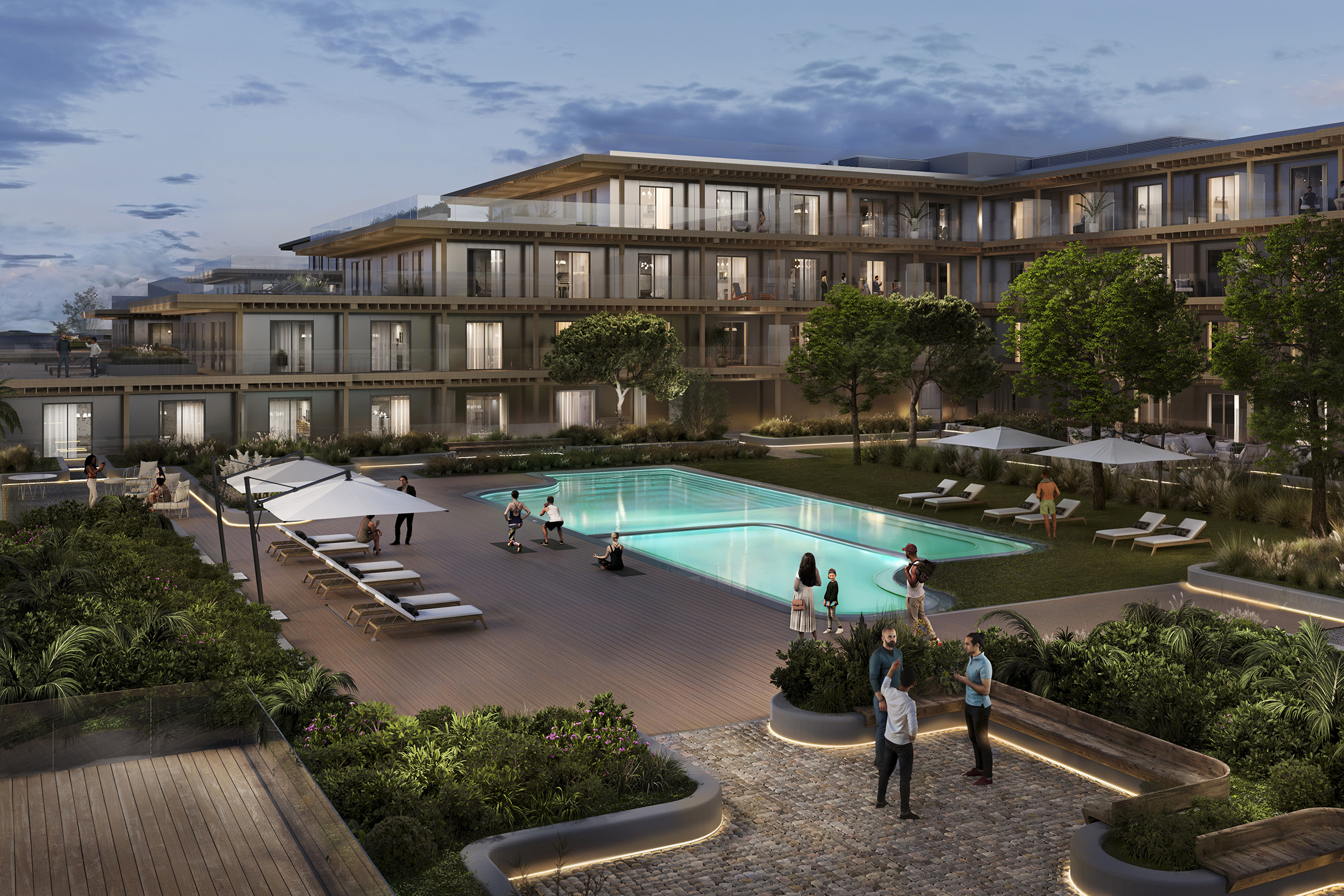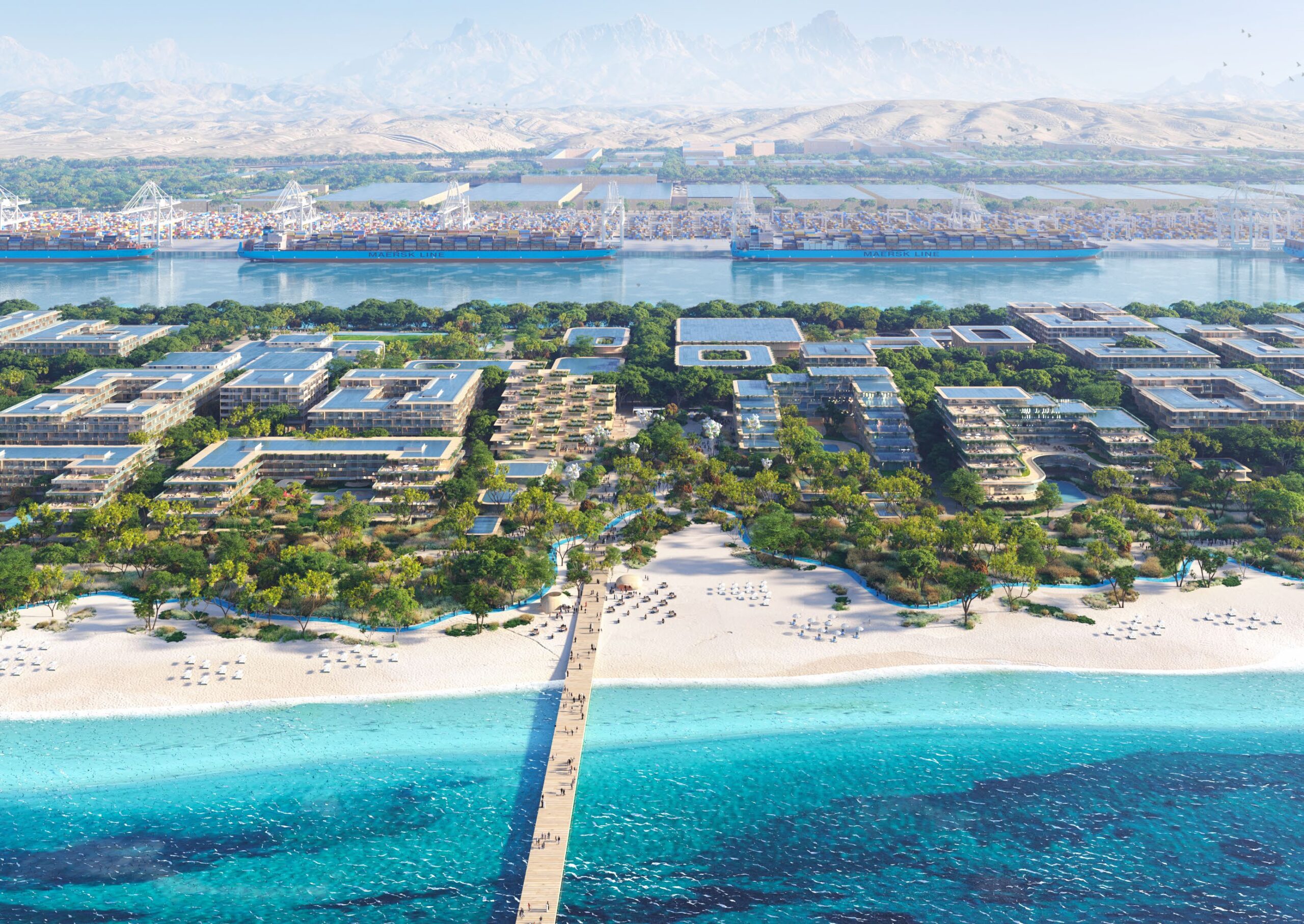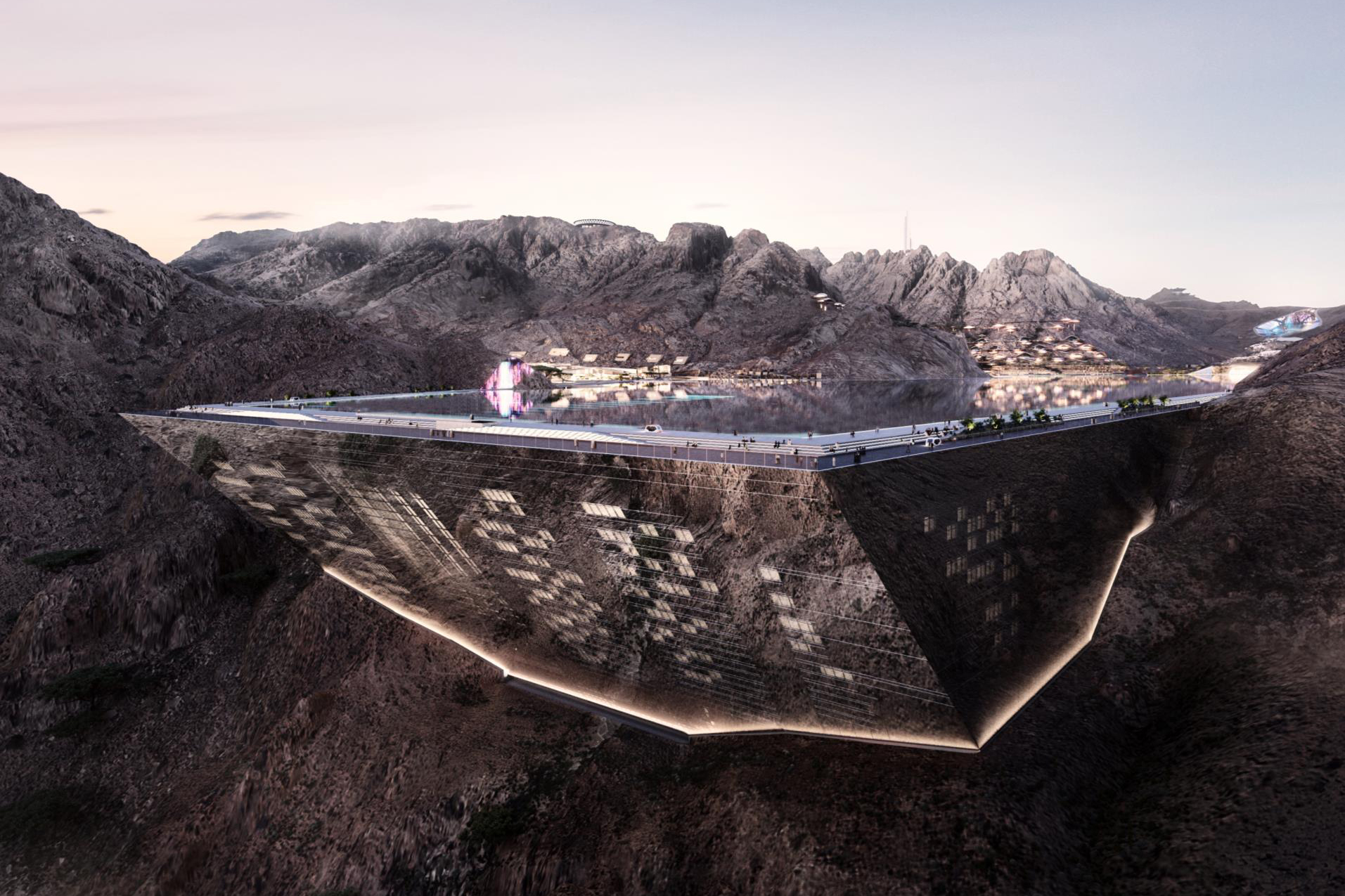
22.09.25
Case Study
This project is a groundbreaking mixed-use development poised to become the first fully realised community within the visionary framework of the Neom Industrial City Masterplan.
Oxagon Village is not merely a development but a city in its own right—an island that embodies the future of sustainable urban living. A self-sustaining oasis, it is designed to offer a harmonious blend of housing, hospitality, commerce, and recreation, with the ambitious goal of housing 23,000 residents across approximately 9,000 residences.
With over two decades of modular design expertise, HKR is proud to have developed the design of Oxagon Village, which stands as a testament to technological ambition and is set to become the world’s largest volumetric modular residential development. Modular construction offers more than speed—it delivers precision, control, and consistency. Off-site fabrication ensures tighter tolerances, reduced waste, and accelerated timelines, all while minimising onsite disruption. It’s a construction method that aligns with the future: efficient, sustainable, and inherently scalable— perfectly suited to the ambition of Oxagon Village.
Upon entering the project post-Concept Design, HKR applied its value-focused design ethos, reassessing viability through the lenses of quality, performance, and cost. The initial scheme, though visionary, exceeded budgetary constraints. Through a meticulous value engineering process, HKR unlocked hidden potential, realigning the design with market realities, user needs, and long-term resilience. Without compromising intent, 25% of the original budget was saved, allowing Oxagon Village to move forward as a model of resourceful innovation and enduring architecture.
Drawing on over 30 years of expertise, HKR brings a legacy of high-performing, commercially successful developments. At Oxagon Village, this experience is sharpened by the use of advanced digital tools—BIM, parametric modelling, and real-time cost dashboards—enabling us to test, validate, and optimise every decision. This approach safeguards programme, cost, and quality, providing clarity and certainty at every stage.
But true value extends beyond economics. We embed environmental and social responsibility into every design move—through optimised site layouts, energy-efficient systems, material circularity, and biodiversity integration. Sustainability is not an afterthought, but the foundation.
In this spirit, Oxagon Village is crafted to achieve LEED Gold certification, ensuring that its impact endures far beyond completion.
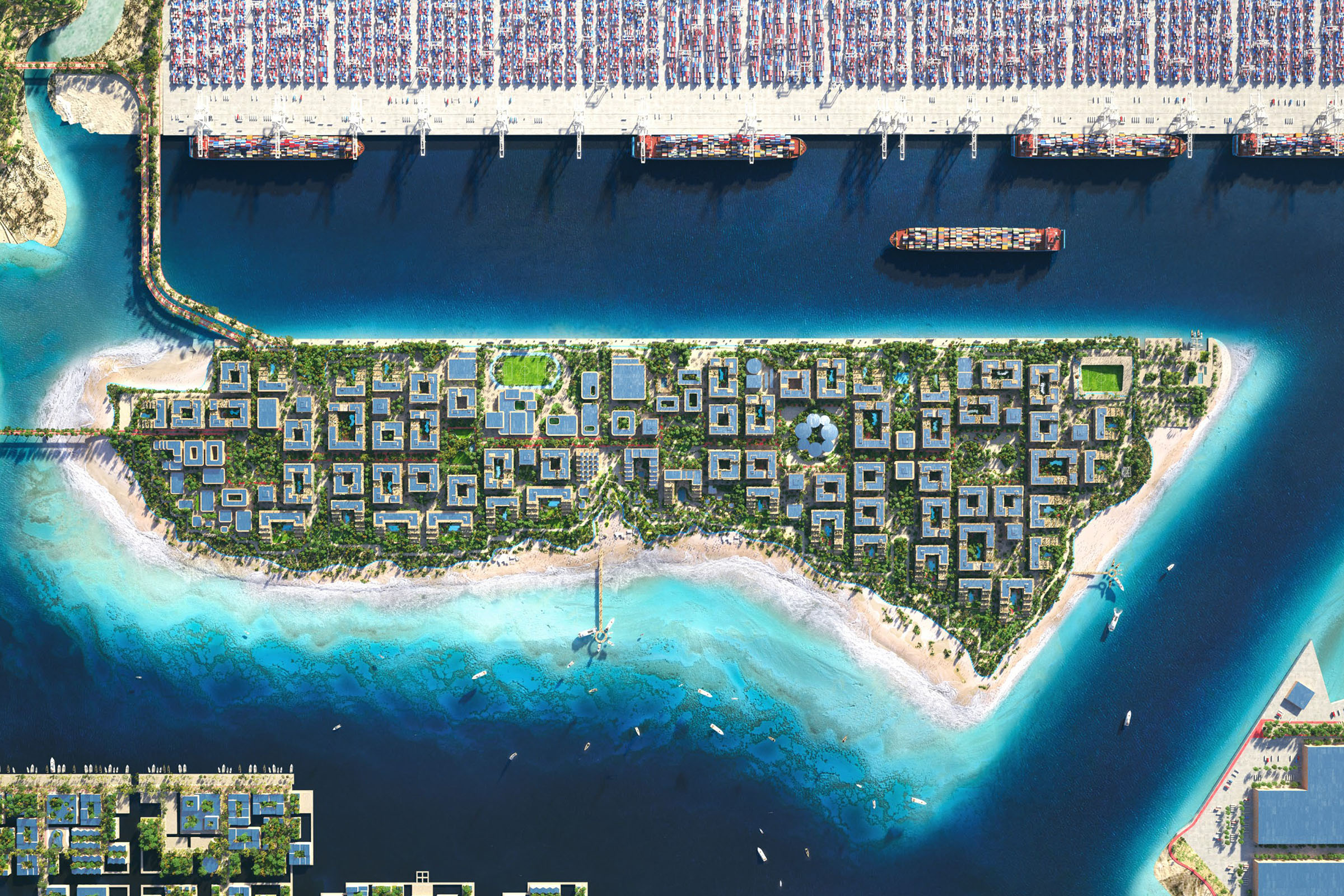
The Cradle for Innovation
Set against the remote vastness of Saudi Arabia’s Northern Borders Province, within the quiet expanse of the Tabuk Region, NEOM unfolds along the western coastline—a frontier of vision and reinvention. Here, Oxagon claims its place in the southwest quadrant of the masterplan, poised between elemental extremes: the infinite horizon of the Red Sea to the west, and the stoic rise of the Shar Mountains to the east. Anchored near one of the world’s most vital shipping routes, this new district is an autonomous port, a logistics hub, a multi-modal network, and an industrial nexus woven into the larger fabric of NEOM.
Within this bold geography, Oxagon Village emerges—a district spanning 129 hectares, quietly positioned to the east of the broader development. The land as it stands today is a coastal plain, marked by uneven topography and fluid contours. In time, the village will be transformed into an island, shaped by the expansion of Oxagon’s port, which will carve away the eastern land, ushering the coastline inland and allowing water to wrap around the site.
Existing energy and utility networks trace the site’s southeast edge, hinting at its industrial legacy as the landscape transforms into one of future urbanism. Against this complex and layered backdrop, Oxagon Village begins its transformation—a new typology of living poised between sea and mountain, past and future.

Precision Engineered — Modular Living at Scale
Rooted in five guiding principles—liveability, community, sustainability, technology, and nature—the masterplan is a walkable, village-like tapestry of streets, squares, and green courtyards, where gently meandering streets form an organic urban fabric. Public services are carefully placed to ensure all residents have access to quality amenities and safe, convenient movement.
Public amenities—schools, clinics, cultural and wellness facilities—are carefully distributed to ensure equitable access for all, stitched together by an integrated network of mobility options. At its core runs a 1.7-kilometre north-south spine, a central mobility corridor linking the north hospitality quarter to a future sports hub in the south. This 20-minute pedestrian thread is punctuated by green parks and civic squares, ensuring that no resident is ever more than three minutes away from a place to gather, rest, or connect. An eastern corridor serves as the island’s primary vehicular route, complementing a coastal promenade that wraps the site to the west. This offers an immersive, sea-facing pedestrian journey that fuses nature with everyday life.


The residential framework encompasses over 1.4 million square metres of built area, comprising a rich mix of mechanical, electrical, and plumbing systems discreetly embedded within, as well as ground-floor retail, commercial, and F&B offerings. The architecture is articulated through two distinct massing typologies: Urban and Coastal. The Urban blocks, six to seven storeys high, form the backbone of the central corridor. Rectilinear in form, they enclose verdant courtyards with private pools—urban retreats offering calm amongst movement.
Along the island’s perimeter, the Coastal typologies take on a different rhythm—stepped, fluid, and responsive to the land’s natural descent. These sculptural forms cascade from five storeys to a single level, anchored by a basement level that houses MEP systems alongside Beach house apartments and Townhouses. Open courtyards flow outward, framing vistas of sea and sky, and integrating pool terraces that engage directly with the coastal promenade.
This massing strategy is a response, concentrating height at the island’s centre, then easing it toward the shore, echoing the natural topography in architectural form. Within this language, seven typologies emerge: three Urban, four Coastal. Each typology is subtly varied through changes in ground floor treatment, basement configuration, and façade articulation. Though unified in their upper layouts, each evolves at ground and basement levels, offering rhythm, diversity, and a design language rooted in topography.
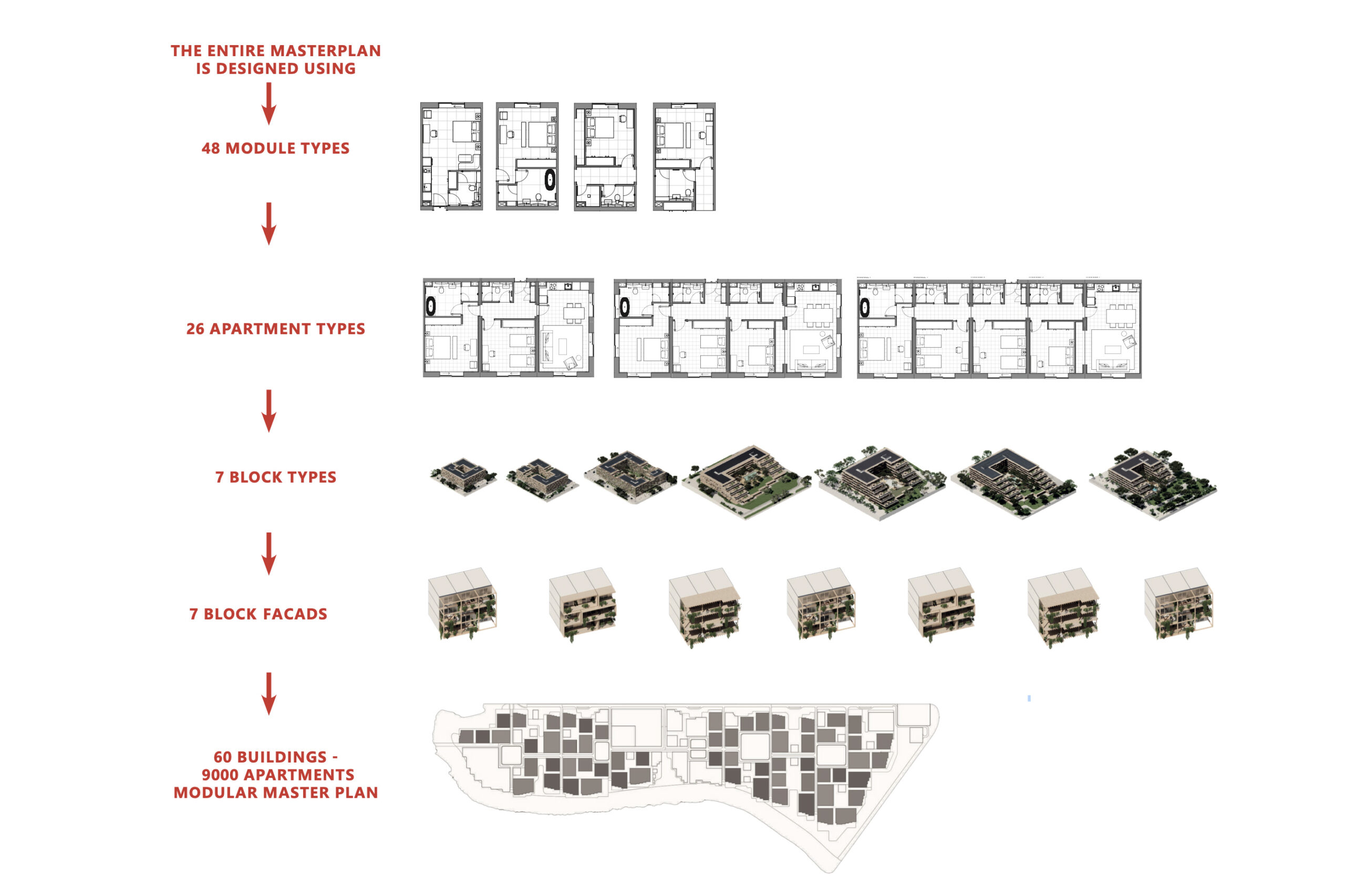
At HKR we put innovation at the forefront of our design principles. Oxagon Village is conceived not only as a community, but as a canvas for construction modernisation— its very bones shaped by the possibilities of modern modular technology. The design embraces a fully volumetric construction strategy, defined under the MMC Framework as Category 1: Pre-manufactured, three-dimensional structural systems. This is architecture assembled with surgical precision—modules pre-crafted offsite, delivered as complete spatial volumes, and orchestrated into place with rhythmic efficiency.
Each residential unit is born from a standardised volumetric module, meticulously dimensioned at 4.5 metres wide, 7.2 metres deep, and 3.5 metres high. These primary building blocks form the DNA of the development, combinable in infinite arrangements to produce a full spectrum of apartment typologies, from intimate one-bedroom homes to expansive five-bedroom dwellings, alongside beach houses and townhouses. Each typology is thoughtfully shaped by its position, orientation, and spatial logic, balancing comfort with efficiency.
A total of 48 unique module types were curated to meet the complex needs of the masterplan, ensuring variety without sacrificing the precision and speed that modular construction affords. Interiors are crafted for clarity, functionality, and dignity of space, with every unit optimised for contemporary living. The design meets both SBC and ICC standards, delivering fully accessible Type A and adaptable Type B units, ensuring inclusivity is embedded into the home’s fabric.
What sets this strategy apart is its manufacturer-agnostic approach, a deliberate design move that empowers the client to pursue competitive procurement across multiple suppliers, enhancing flexibility, resilience, and cost efficiency. This is a system of making that speaks to the future: agile, scalable, and beautifully repeatable—an architecture that understands the value of time, without compromising on space, dignity, or detail.
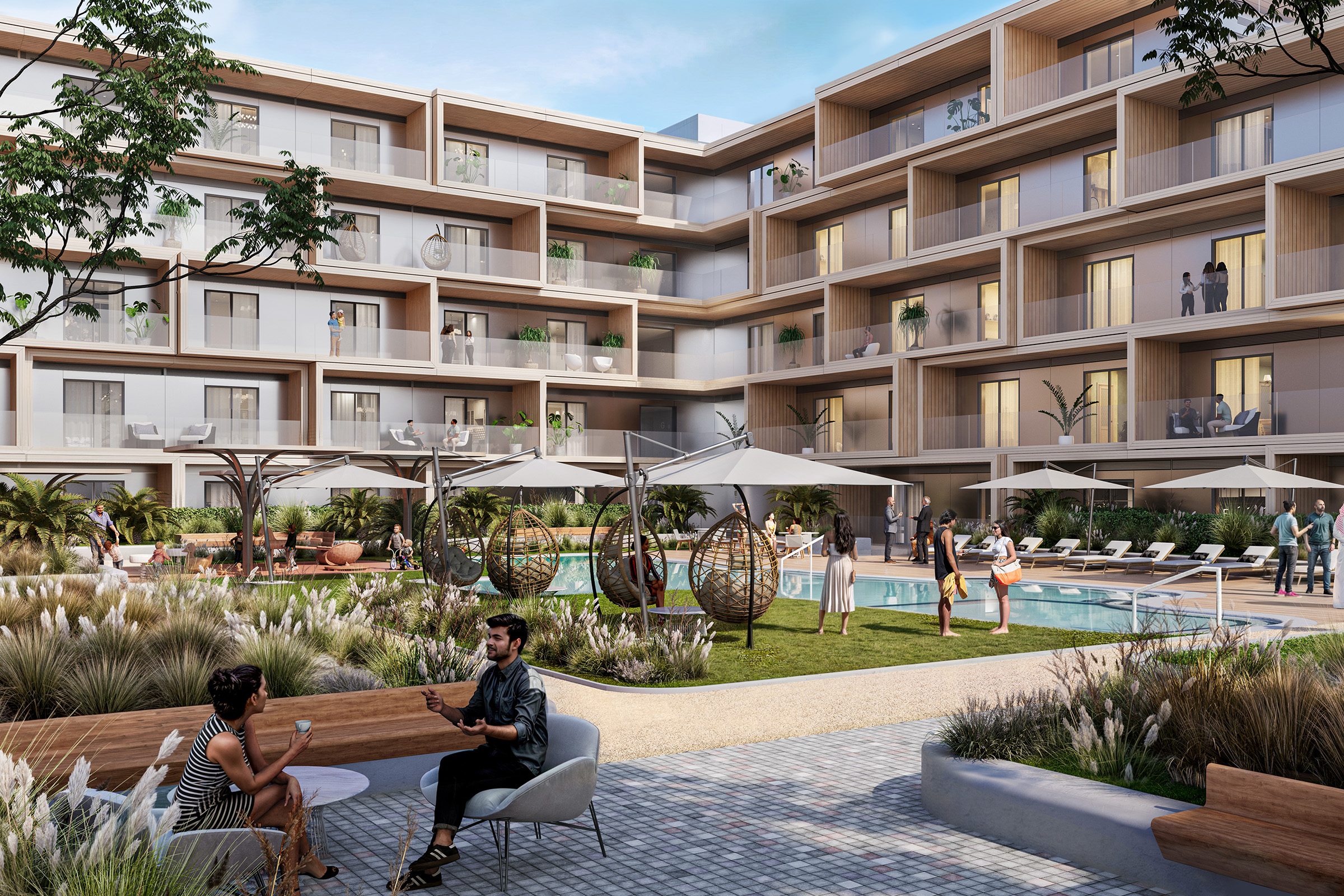
A Tapestry of Texture: The Façade Language
Five distinct façades weave character into the Oxagon Village masterplan, orchestrating a rhythmic dialogue between coastline and village core. Along the coast, The Porch, Cassette In & Out, and Simplified façades animate the waterfront edge, responding to the informal rhythm of the shoreline. In contrast, the Urban core is defined by the more structured Chamfer and Grid façades.
The Grid typology, acting as the base language of the urban blocks, integrates four Loggia variations, introducing vertical shifts, spatial depth, and private balconies. Meanwhile, the Chamfer façade, with or without balcony, brings sculptural assistance to the built form—refined, monolithic, and deliberate. These façade types are choreographed across the site to enrich the streetscape, balancing repetition with visual intrigue.
An assortment of materials articulates the facades, bringing more enthusiasm to the masterplan. Coastal buildings adopt light wood veneered aluminium cladding, distinguished by dark-toned openings highlighting natural warmth and texture. Urban blocks contrast with light-toned engineered stone for the grid façades and GRC panels for the Chamfers, complemented by grey-framed windows and doors. Retail frontages are defined by large, glazed facades, grounding the pedestrian scale with a tactile presence.
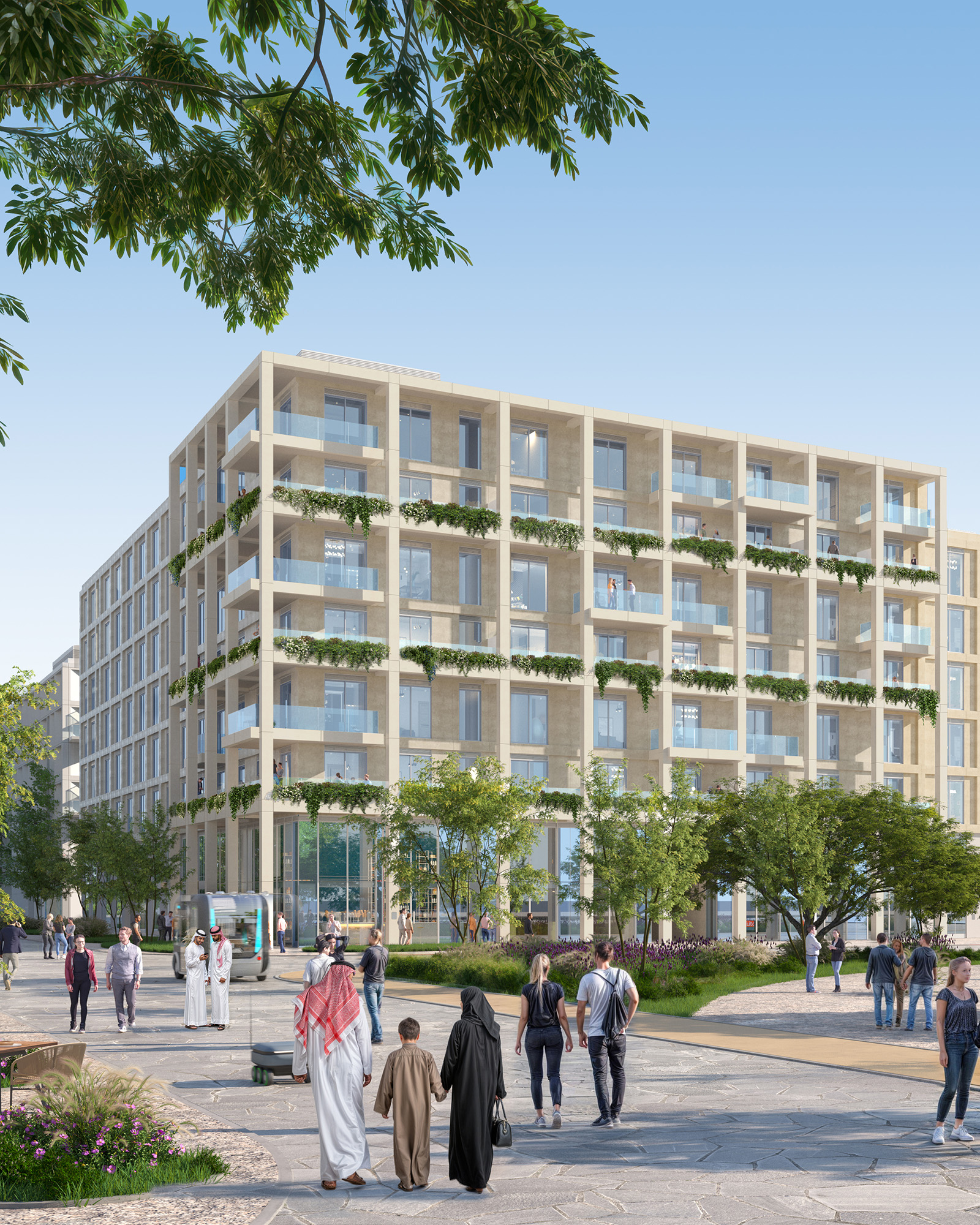
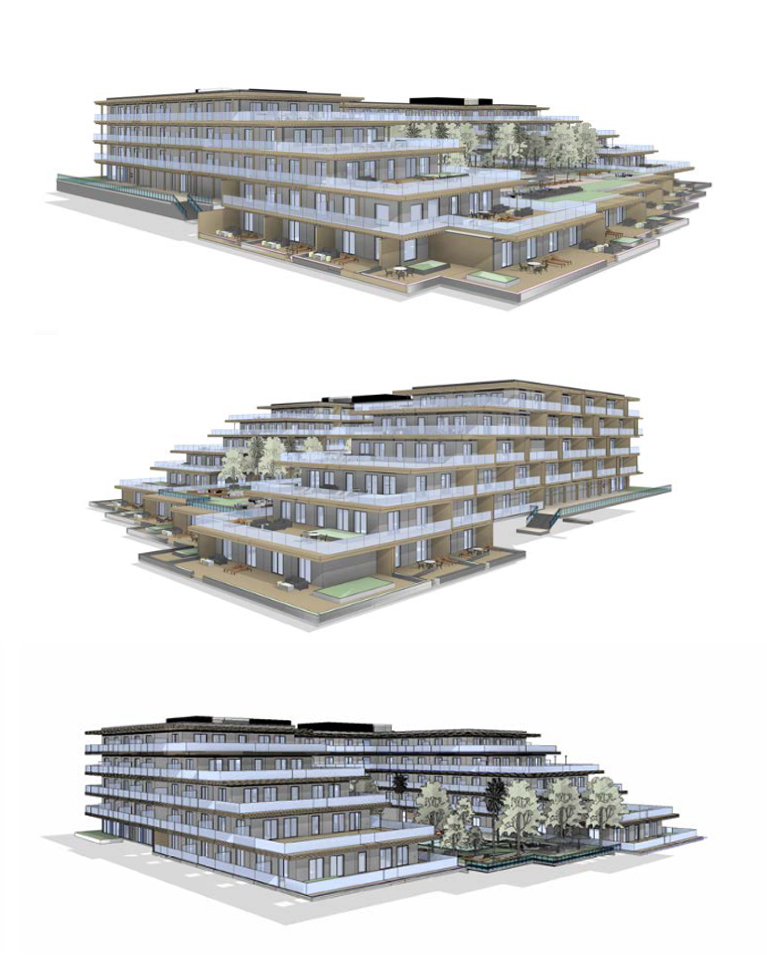
Craft Meets Contraint
HKR’s design philosophy embraces ‘value-focused design’, delivering architecture that performs across commercial, operational, and environmental metrics As the façades took form, the design process confronted key challenges with equal parts ingenuity and restraint:
• BALCONY CANTILEVERS: Early concepts proposed bold 6m projections on coastal buildings. Though dramatic, these required heavy structure and cost implications. HKR refined the cantilever to maintain elegance without compromising vision or budget.
• TIMBER FAÇADE: Originally specified in ThermoWood for its natural beauty and sustainability, fire safety concerns led to the selection of TechnoWood—a non-combustible aluminium panel with a wood veneer finish, marrying aesthetics with performance.
• CHAMFER PRECISION: The design ambition was a seamless, sculpted monolith. In close collaboration with the façade consultant, GRC (Glassfibre Reinforced Concrete) was selected—it is mouldable, resilient, and capable of delivering the chamfer’s continuous, joint-free geometry.
The result is a façade strategy that merges expression with engineering, grounding the village in material integrity and architectural clarity.
Fuelled by research and development, at HKR, innovation is defined by relevance, rigour, and responsiveness. Using our extensive experience in the modular industry, we developed an intelligent balcony connection system—a refined, universal solution seamlessly integrated across all façade types. A small detail, engineered with precision, that enables design continuity at scale.
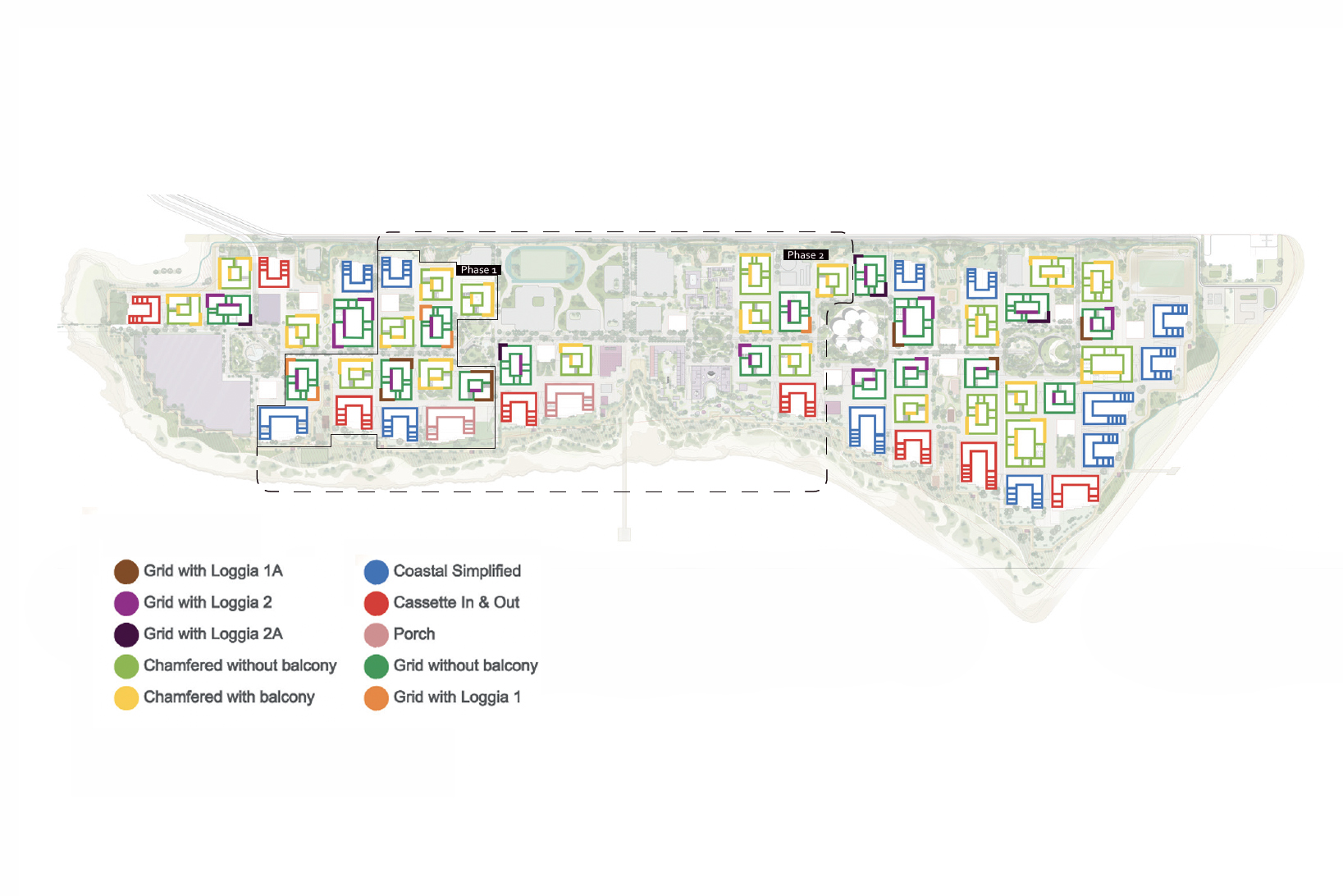
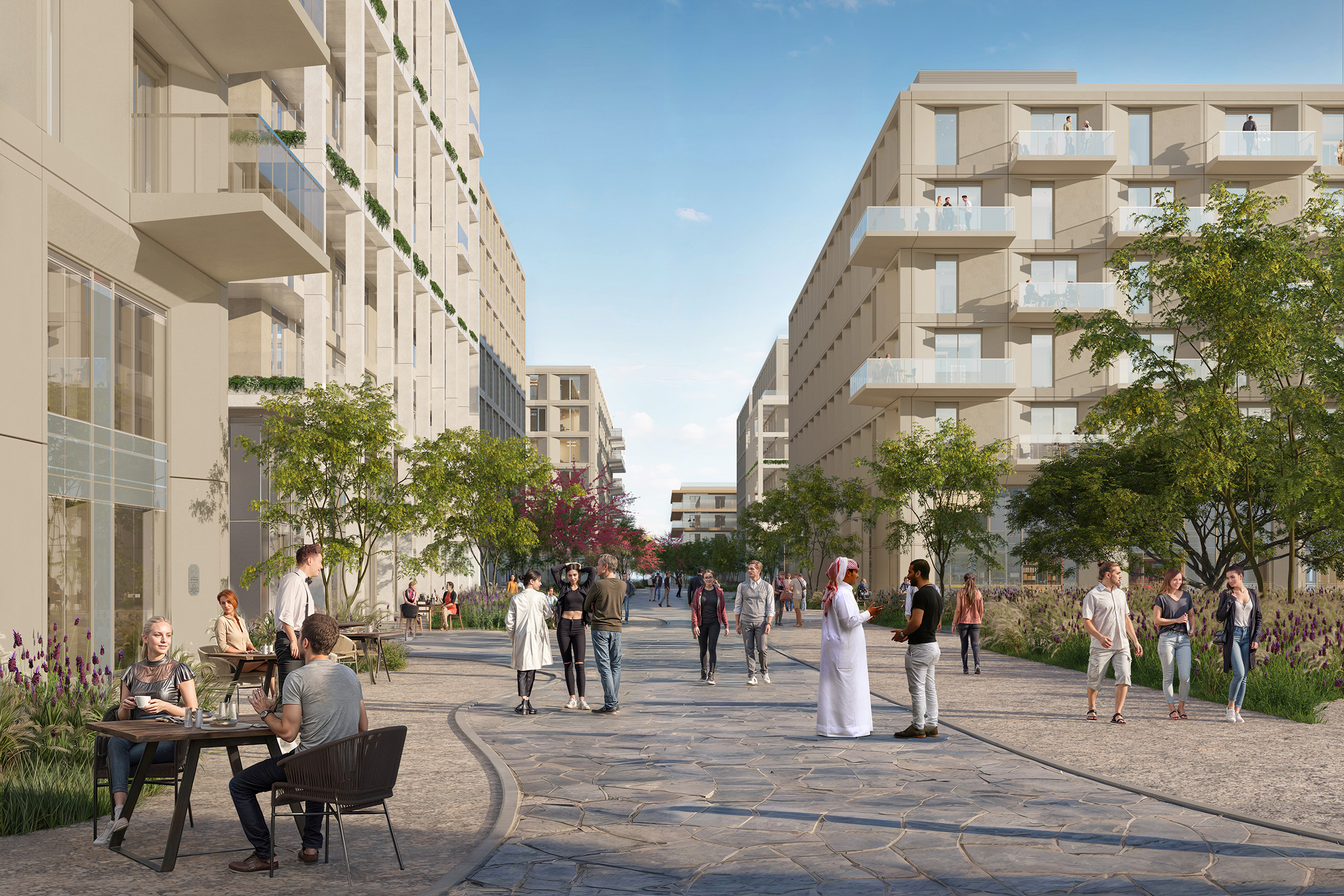
Fuelled by research and development, at HKR, innovation is defined by relevance, rigour, and responsiveness.

Activating the Streetscape
The ground floor of each residential building is carefully attuned to the masterplan’s communal, operational, and organisational rhythms. Its programme flexes with context —
Along the main corridor and public squares, ground floors are activated with retail, F&B, and commercial spaces, energising the public realm and reinforcing the urban cadence.
Buildings set deeper within the site host private amenities— gyms, lounges, and communal spaces—fostering a sense of neighbourhood.
Meanwhile, façades lining internal courtyards discreetly accommodate MEP spaces, ensuring vital operational infrastructure is seamlessly integrated without compromising the landscape or user experience.
This layered approach crafts a vibrant, responsive ground plane, where each edge contributes to the life and performance of the village. This is further enhanced through the articulation of a climate-conscious landscape design.
Rooted in climate resilience and placemaking, the landscape design weaves sustainability into every surface. SUDS strategies and permeable paving manage water intelligently, while shading canopies, both natural and artificial, offer refuge from heat. A palette of native, drought-tolerant planting cools the environment, stitched together with play areas, gathering spaces, and a central pool to foster wellbeing and community.
Touches of colour animate the landscape—powder-coated metal canopies, movable furniture, and gym equipment— introducing vibrancy without compromising performance. It is a terrain both tactile and thoughtful, where ecology and identity shape a shared future.
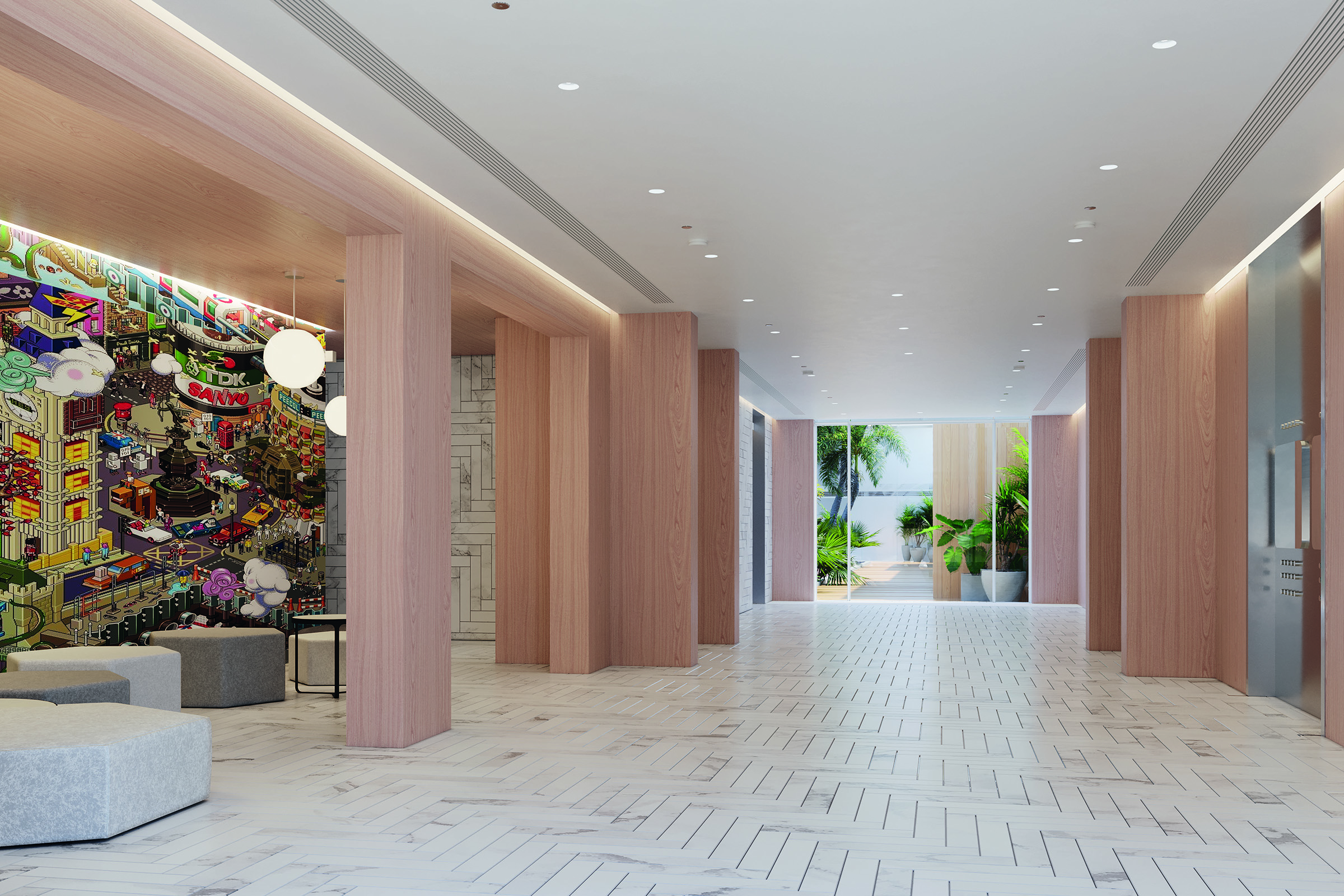
Built to Perform
Oxagon Villages’ modular nature offers a higher building performance standard by design. Factory controlled environments enable seamless integration of MEP systems, with each module arriving pre-fitted and precisely coordinated.
This ensures greater structural integrity, enhanced acoustic separation, and robust fire safety, all engineered to repeat flawlessly. Off-site production also significantly reduces material waste and onsite disruption, resulting in a process that is cleaner, quieter, and more efficient—a smarter, more integrated way to build.
